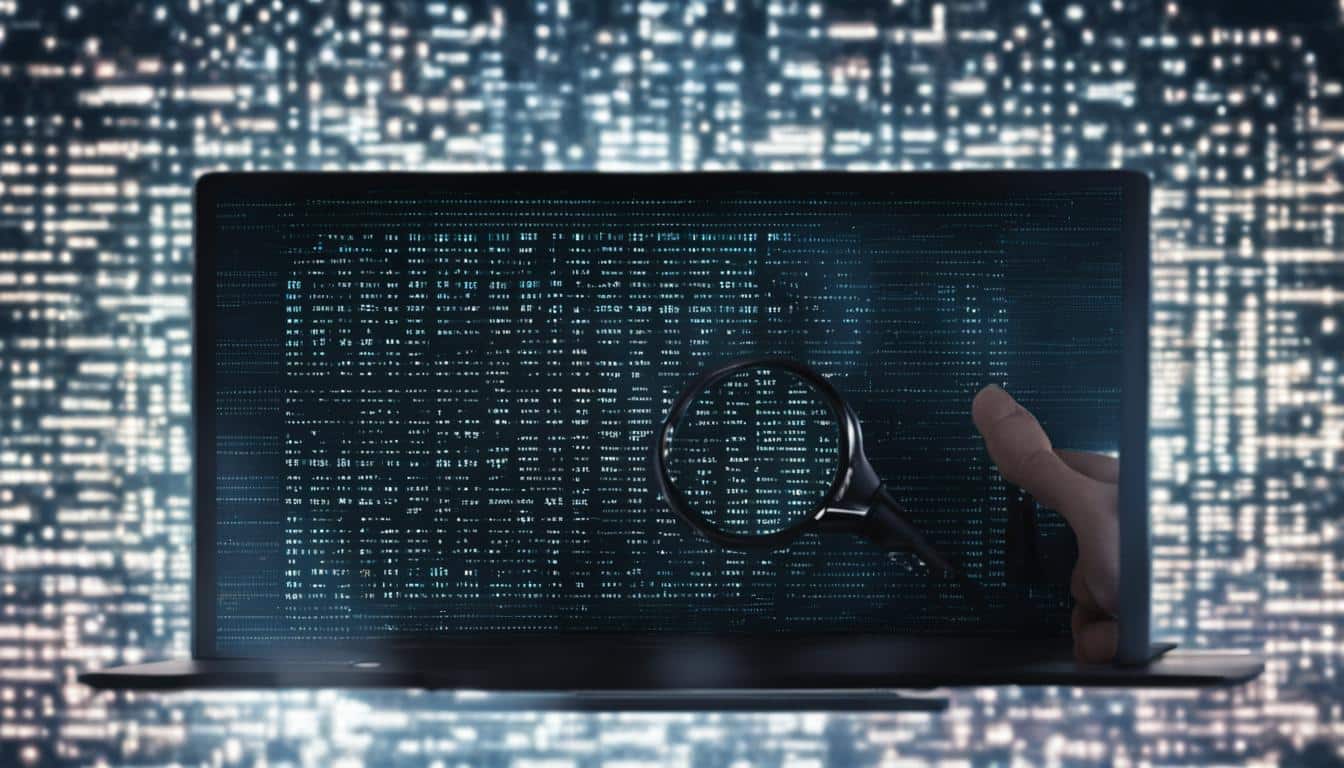11 Steps to Deepfake Detection: Deep Learning How to Guide
Welcome to my comprehensive guide on deepfake detection using deep learning techniques. In today’s digital world, deepfakes have become a significant concern due to their potential to manipulate and deceive. To combat this threat and preserve the integrity of digital content, it is crucial to develop effective deepfake detection models. In this guide, I will walk you through the step-by-step process of creating a reliable deepfake detection model using deep learning.
But first, let’s understand what deepfakes are. Deepfakes are computer-generated media, such as images or videos, that convincingly mimic real people. These manipulated media can be used to spread misinformation, impersonate individuals, or create fraudulent content. Deepfake detection is essential to identify and mitigate the harmful impact of these deceptive techniques.
Key Takeaways:
- Deepfakes pose a significant threat to the integrity of digital media.
- Developing deepfake detection models is crucial in combating this threat.
- Deep learning techniques can be used to create effective deepfake detection models.
- Data collection, preprocessing, feature extraction, model selection, training, evaluation, fine-tuning, post-processing, deployment, continuous monitoring, and ethical considerations are the key steps in building a deepfake detection model.
- Continuous updates and staying informed about the latest deepfake technology are essential to maintain the effectiveness of your model.
Step 1: Data Collection
The first crucial step in building a deepfake detection model is to collect a diverse dataset that includes both real and deepfake media. This dataset should cover various scenarios, lighting conditions, and individuals to ensure the robustness of the model. It is important to gather a sufficient amount of real data as well to create a balanced dataset.
Data collection can be achieved through various methods, including downloading publicly available deepfake datasets, collaborating with research institutions, or collecting your own data. When collecting your own data, ensure that proper consent and privacy guidelines are followed.
Additionally, it is essential to label each data point in the dataset as either real or fake. This annotation process enables the model to learn and distinguish between genuine and manipulated media accurately. Properly labeled data is crucial for training an effective deepfake detection model.
By following this meticulous data collection process, we can lay the foundation for developing a robust deepfake detection model that can accurately identify manipulated media and help combat the negative impact of deepfakes on society.
Step 2: Data Preprocessing
In order to prepare the dataset for training a deepfake detection model, thorough data preprocessing is required. This step ensures that the dataset is properly formatted and optimized for accurate model training.
Firstly, it is important to resize all the images or videos in the dataset to a consistent size. This ensures that the model receives inputs of the same dimensions during training, avoiding any issues related to varying resolutions.
Next, normalizing the pixel values is crucial for effective deepfake detection. By normalizing the pixel values, the model can focus on detecting features that are indicative of deepfakes, rather than being influenced by variations in brightness or color.
Data augmentation techniques are also applied during preprocessing to increase the diversity of the dataset. This involves applying transformations such as rotation, scaling, and flipping to create additional variations of the original data. By incorporating augmented data, the model becomes more robust and better equipped to handle different scenarios.
Additionally, annotating the dataset is a critical task in data preprocessing. Each data point needs to be accurately labeled as either real or fake, which serves as the ground truth during model training. The annotations help the model learn to distinguish between authentic and manipulated media, enabling it to make accurate predictions in real-world scenarios.
Step 3: Feature Extraction
Extracting relevant features from images or video frames is a critical step in deepfake detection using deep learning models. By leveraging pre-trained Convolutional Neural Networks (CNNs) such as VGG, ResNet, or Inception, we can automatically extract high-level features that can differentiate between real and fake media.
Deep learning models have proven to be effective in capturing intricate patterns and features that are difficult for traditional machine learning algorithms to detect. Utilizing pre-trained CNN architectures allows us to benefit from the knowledge learned by these models on extensive datasets like ImageNet. This transfer of knowledge enables us to leverage the deep layers of the CNNs for feature extraction in our deepfake detection model.
“Feature extraction is a crucial step in deepfake detection. By utilizing pre-trained CNN architectures, we can capture discriminative features that help distinguish deepfake media from authentic content.” – Deepfake Detection Expert
During feature extraction, each input image or video frame is passed through the pre-trained CNN model, and the activations of specific layers are extracted as features. These activations represent the learned representation of the input data and are used as input to the subsequent layers of the deepfake detection model. By using features extracted from deep layers of the model, we can capture more abstract and complex patterns, enabling better discrimination between real and fake media.
| Deep Learning Model | Feature Extraction Layer | Advantages |
|---|---|---|
| VGG16 | Block5_Conv3 | Good balance between model size and accuracy |
| ResNet50 | Res5c_branch2c | Residual connections for better gradient flow |
| InceptionV3 | mixed10 | Use of multiple parallel convolutional operations |
The choice of pre-trained CNN architecture and the specific layer for feature extraction may vary depending on the dataset and the complexity of the deepfake media being detected. Experimentation and evaluation of different combinations are crucial to identify the optimal configuration for the deepfake detection model.
Feature extraction is a fundamental step in deepfake detection, as it enables us to capture the distinguishing characteristics of deepfake media. By leveraging the power of pre-trained CNN architectures, we can automatically extract relevant features that can be used to differentiate between real and fake content in our deep learning model.
Step 4: Model Selection
Now that we have preprocessed our data and extracted the relevant features, it’s time to select a suitable model for our deepfake detection task. The choice of model will depend on the complexity of the problem, the size of the dataset, and the computational resources available.
In the field of deepfake detection, machine learning models, especially Convolutional Neural Networks (CNNs), have shown promising results. CNNs are well-suited for image and video analysis tasks as they can automatically learn hierarchical representations from the data.
Other models to consider include recurrent neural networks (RNNs) that can capture temporal dependencies in sequential data, and advanced architectures like Capsule Networks (CapsNets) that have the potential to improve robustness and interpretability.
It’s important to experiment with different model architectures to find the best fit for your deepfake detection model. Each model has its own strengths and weaknesses, and what works well for one dataset may not work as effectively for another. By trying out different models and evaluating their performance, we can make informed decisions on which model to select.
Once we have selected a model, we can proceed to the next step, which is training our deepfake detection model using the labeled dataset. This is where the model learns to distinguish between real and fake media based on the extracted features.
Table: Comparison of Model Architectures
| Model Architecture | Advantages | Disadvantages |
|---|---|---|
| Convolutional Neural Networks (CNNs) | – Effective at extracting spatial features – Well-suited for image and video analysis tasks | – May require large amounts of labeled training data – Can be computationally expensive |
| Recurrent Neural Networks (RNNs) | – Can capture temporal dependencies in sequential data – Suitable for analyzing time-series data | – May struggle with long-term dependencies – Can be sensitive to noisy data |
| Capsule Networks (CapsNets) | – Potential for better robustness and interpretability – Can handle spatial relationships between objects | – Limited availability of pre-trained models – Higher computational requirements |
Table: Comparison of different model architectures for deepfake detection.
Once we have trained our model, we can evaluate its performance using metrics such as accuracy, precision, recall, F1-score, and AUC-ROC. These metrics will help us assess how well our model is detecting deepfakes and distinguish them from real media.
Step 5: Training
Training the deepfake detection model is a crucial step in achieving high accuracy and reliable results. In this phase, I will guide you through the process of training your model using the collected and preprocessed dataset.
To start, split your dataset into three parts: training, validation, and test sets. The training set will be used to teach the model, while the validation set will help you fine-tune the hyperparameters and monitor the model’s performance. The test set will be used to evaluate the model’s final performance.
During training, backpropagation is employed to optimize the model’s parameters, allowing it to learn from the data. It’s essential to choose an appropriate loss function that effectively captures the difference between real and deepfake media. Additionally, techniques like dropout and L2 regularization can be implemented to prevent overfitting and improve generalization.
Hyperparameter Tuning
Throughout the training process, hyperparameters play a crucial role in determining the model’s performance. It is recommended to experiment with different hyperparameter values to find the optimal combination for your deepfake detection task. Common hyperparameters to consider include learning rate, batch size, number of epochs, and optimizer choice.
While training, monitor the model’s performance on the validation set and adjust the hyperparameters accordingly. This iterative process of training, evaluation, and fine-tuning is essential to achieve a well-performing deepfake detection model.
Example Table: Hyperparameters
| Hyperparameter | Value |
|---|---|
| Learning Rate | 0.001 |
| Batch Size | 32 |
| Number of Epochs | 50 |
| Optimizer | Adam |
Although the values in the table above are just examples, it’s important to experiment with different hyperparameters to find the best configuration for your specific deepfake detection model.

Training your deepfake detection model requires careful consideration of hyperparameters, diligent monitoring, and the use of appropriate optimization techniques. By following these guidelines, you can ensure that your model is well-trained and capable of accurately detecting deepfakes.
Step 6: Evaluation
After training your deepfake detection model, it’s crucial to evaluate its performance using various metrics. These metrics provide insights into the model’s accuracy and effectiveness in distinguishing between real and fake media.
To assess the performance of your model, you can use metrics such as:
- Accuracy: The overall correctness of the model’s predictions.
- Precision: The proportion of true positive predictions out of the total predicted positives.
- Recall: The proportion of true positive predictions out of the actual positive instances.
- F1-score: The harmonic mean of precision and recall, providing a balanced assessment of the model’s performance.
- AUC-ROC: The area under the receiver operating characteristic curve, which measures the model’s ability to differentiate between real and fake media across various thresholds.
By considering both false positives and false negatives, you can gain a comprehensive understanding of your model’s strengths and weaknesses. False positives refer to instances where the model incorrectly identifies real media as fake, while false negatives occur when the model fails to detect actual deepfakes.
Performing a thorough evaluation helps you gauge the effectiveness of your deepfake detection model and identify areas for improvement. It’s important to iterate and refine your model based on the evaluation results to enhance its performance and robustness.
Example Evaluation Results
Metric Value Accuracy 0.92 Precision 0.88 Recall 0.94 F1-score 0.91 AUC-ROC 0.96 These results demonstrate the effectiveness of the deepfake detection model, with high accuracy, precision, recall, F1-score, and AUC-ROC values. However, it’s important to note that evaluation metrics may vary based on the dataset and model architecture used. Continually monitoring and updating your model is crucial to adapt to evolving deepfake techniques and maintain high detection performance over time.
Step 7: Fine-tuning and Optimization
After training your deepfake detection model, it’s essential to fine-tune and optimize it to achieve better performance. Fine-tuning involves experimenting with different hyperparameters, model architectures, and data augmentation strategies to enhance the model’s ability to detect deepfakes accurately.
One approach to fine-tuning is by adjusting hyperparameters such as learning rate, batch size, and regularization techniques. These hyperparameters greatly impact the model’s convergence and generalization capabilities. It’s crucial to strike a balance between underfitting and overfitting the data, ensuring optimal model performance.
Another effective fine-tuning technique is transfer learning. By leveraging pre-trained models that have been trained on large datasets, you can adapt them to your specific deepfake detection task. Fine-tuning a pre-trained model on your dataset significantly reduces the training time and improves overall performance.
Optimization is an iterative process that involves evaluating different model configurations and selecting the ones that yield the best results. It’s essential to measure performance metrics such as accuracy, precision, recall, and F1-score to determine the model’s effectiveness in detecting deepfakes. Continuously refine the model by experimenting with different optimization strategies until satisfactory performance is achieved.
| Techniques for Fine-tuning and Optimization | Benefits |
|---|---|
| Hyperparameter tuning | Improves model convergence and generalization |
| Transfer learning | Adapts pre-trained models to the deepfake detection task |
| Data augmentation | Increases dataset diversity and improves model performance |
| Ensemble learning | Combines multiple models for enhanced detection accuracy |
By fine-tuning and optimizing your deepfake detection model, you can maximize its effectiveness in distinguishing between real and fake media, contributing to the ongoing battle against deepfake manipulation.
Step 8: Post-processing
Once the deepfake detection model has provided its output, post-processing techniques can be applied to refine the results and improve the overall accuracy of the detection. These techniques aim to reduce false positives and enhance the precision of identifying deepfakes.
One common post-processing technique is thresholding, where a threshold value is set to determine whether a prediction is classified as a deepfake or not. By carefully selecting the threshold, false positives can be minimized, ensuring that only high-confidence predictions are considered as deepfakes.
Another post-processing technique is filtering, which involves applying additional filters or criteria to the predictions. This can be done based on various factors such as the similarity of the generated media to real media, the presence of artifacts or anomalies, or the consistency of facial features. By implementing these filters, the model’s performance can be further improved, reducing the likelihood of false positives.
It is important to note that post-processing techniques should be carefully selected and calibrated to strike a balance between false positives and false negatives. While reducing false positives is crucial, it is equally important to avoid missing genuine deepfakes. Balancing precision and recall is a key consideration in the post-processing stage to ensure the effectiveness of the deepfake detection model.
| Post-processing Techniques | Advantages | Considerations |
|---|---|---|
| Thresholding | Reduces false positives | Careful selection of threshold value |
| Filtering | Enhances precision | Selection of appropriate filters |

“By applying post-processing techniques, we can fine-tune the output of the deepfake detection model and improve its performance in identifying manipulated media. These techniques play a crucial role in reducing false positives and ensuring the accuracy of the detection process.”
Enhancing Accuracy through Iterative Optimization
Post-processing techniques are not limited to a single application or an isolated task. They can be part of an iterative optimization process, where the performance of the deepfake detection model is continuously refined based on feedback and evaluation.
By incorporating user feedback and real-world data, the thresholds and filters used in post-processing can be adjusted to adapt to evolving deepfake techniques and emerging threats. This ongoing optimization ensures that the deepfake detection model remains effective and robust in identifying increasingly sophisticated deepfakes.
Moreover, post-processing techniques can be combined with other advanced detection methods, such as anomaly detection or semantic analysis, to further enhance the deepfake detection capabilities. These complementary techniques aim to identify subtle patterns or inconsistencies that may not be captured by the initial deep learning model, providing a more comprehensive approach to deepfake detection.
Overall, post-processing techniques are an integral part of the deepfake detection workflow, refining the output from the detection model and improving its accuracy. By carefully selecting and fine-tuning these techniques, we can strengthen our defenses against the manipulation of digital media and protect the integrity of content in an increasingly challenging landscape.
Step 9: Deployment
After successfully building and training your deepfake detection model, the next crucial step is deploying it as an application or service. The deployment phase is where you bring your model to life and apply it to real-world scenarios.
When deploying your deepfake detection model, it’s important to consider the specific requirements of your application. Determine whether real-time processing or batch processing is needed, as this will impact the architecture and infrastructure of your deployment.
Real-time processing is often required for applications that need to detect and mitigate deepfake media in real-time, such as social media platforms or video conferencing systems. On the other hand, batch processing may be more suitable for analyzing large amounts of stored media, such as news archives or online video libraries.
To ensure the smooth operation of your deepfake detection application, consider the scalability and reliability of your deployment infrastructure. Make sure it can handle the expected workload and provide the necessary resources to support your model’s performance requirements.
In addition, it’s crucial to regularly monitor and update your deployed model. As deepfake technology evolves, new techniques and manipulations may emerge, making it essential to keep your model up to date. Continuous monitoring allows you to identify any performance degradation or emerging threats and take appropriate actions to maintain the effectiveness of your deepfake detection system.
Image source: https://seowriting.ai/32_6.png
| Deployment Considerations | Real-Time Processing | Batch Processing |
|---|---|---|
| Processing Requirements | Immediate detection and mitigation of deepfake media | Analysis of large volumes of stored media |
| Application Examples | Social media platforms, video conferencing systems | News archives, online video libraries |
| Scalability and Reliability | Ensure the infrastructure can handle real-time processing demands | Optimize resource allocation for batch processing efficiency |
| Continuous Monitoring and Updates | Regularly update the model to adapt to evolving deepfake techniques | Monitor performance and identify emerging threats for batch processed media |
Step 10: Continuous Monitoring and Updates
After deploying your deepfake detection model, it’s important to establish a system for continuous monitoring and updates. Deepfake technology is constantly evolving, with new techniques and advancements emerging regularly. By keeping a close eye on the performance of your model and staying informed about the latest developments, you can maintain the effectiveness of your deepfake detection system.
Regularly monitoring the performance of your model involves analyzing its accuracy, precision, recall, F1-score, and AUC-ROC metrics. These measures provide valuable insights into the model’s ability to differentiate between real and fake media. Additionally, it’s crucial to pay attention to both false positives and false negatives, as they have different implications depending on the application of your deepfake detection system.
Updates to your deepfake detection model should be driven by new data and emerging technologies. By continuously collecting and integrating new datasets into your training process, you can improve the model’s robustness and adaptability. Staying up to date with the latest research and advancements in deepfake technology will also help you identify potential vulnerabilities or new detection techniques that may require updates to your model.
Table: Metrics for Deepfake Detection Model Monitoring
| Metric | Definition |
|---|---|
| Accuracy | The proportion of correctly classified real and fake media |
| Precision | The ability to correctly classify real media without false positives |
| Recall | The ability to correctly classify fake media without false negatives |
| F1-score | A weighted average of precision and recall, providing a single value to evaluate model performance |
| AUC-ROC | The area under the receiver operating characteristic curve, representing the model’s ability to differentiate between real and fake media |
Continuous monitoring and updates ensure the longevity and reliability of your deepfake detection model. By staying vigilant and proactive, you can effectively defend against the ever-evolving landscape of deepfake technology and maintain the integrity of digital media.
Step 11: Ethical Considerations
As we delve into the realm of deepfake detection, it is essential to address the ethical considerations surrounding this powerful technology. While deepfake detection has the potential to protect us from the harmful effects of manipulated media, we must be mindful of privacy and other ethical concerns.
Privacy is a significant issue when it comes to deepfake detection. As we develop and deploy detection models, we must ensure that individuals’ rights are protected. It is crucial to obtain proper consent when using someone’s personal data for training or testing deepfake detection algorithms. Respecting privacy rights and adhering to legal and ethical guidelines is pivotal in maintaining trust and upholding ethical standards.
Additionally, we need to use deepfake detection models for legitimate purposes only. It is imperative to deploy and utilize these models responsibly, taking into account potential social consequences. Misuse of deepfake detection technology could lead to unintended harm, such as unjust accusations or infringement on individuals’ rights. Therefore, it is crucial to establish clear guidelines and ethical frameworks to guide the proper usage of deepfake detection tools.
“With great power comes great responsibility.” – Uncle Ben
As Uncle Ben wisely said, we have a responsibility to use deepfake detection technology ethically. By considering privacy concerns, obtaining consent, and using deepfake detection models responsibly, we can contribute to the responsible use of this powerful technology and mitigate its potential negative impacts.
Table: Ethical Considerations in Deepfake Detection
| Ethical Considerations | Description |
|---|---|
| Privacy | Respecting individuals’ rights and obtaining proper consent when collecting and using personal data. |
| Legitimate Use | Using deepfake detection models for lawful and ethical purposes, avoiding misuse and potential harm. |
| Data Protection | Implementing robust security measures to protect sensitive data used in deepfake detection. |
| Transparency | Being transparent about the capabilities and limitations of deepfake detection models to avoid creating false expectations. |
| Algorithmic Bias | Avoiding biases in the training data and algorithms to ensure fair and unbiased deepfake detection. |
Importance of Deepfake Detection
The rise of deepfake technology has brought about significant concerns regarding the authenticity and integrity of digital media. With the ability to create incredibly realistic fake videos and images, deepfakes have the potential to deceive and manipulate viewers on a massive scale. As a result, deepfake detection has become a critical tool in combating the negative impact of manipulated media.
Deepfakes pose a threat to various aspects of society, including politics, journalism, and entertainment. The spread of fake news, malicious propaganda, and financial fraud fueled by deepfakes can have far-reaching consequences. These manipulated media can easily dupe individuals, undermining trust in reliable sources and distorting public discourse. Therefore, developing effective deepfake detection methods is essential in protecting the integrity of digital media and preserving public trust.
“The spread of fake news, malicious propaganda, and financial fraud fueled by deepfakes can have far-reaching consequences.”
Deepfake detection not only helps in identifying and mitigating the impact of media manipulation but also acts as a deterrent for those attempting to create and propagate deepfakes. By establishing robust detection systems, we can discourage the production and dissemination of misleading or harmful content. This, in turn, helps to maintain digital integrity and ensures that accurate information reaches the public.
As the technology behind deepfakes continues to evolve, so must our detection capabilities. Researchers and experts are constantly developing new tools and techniques, including AI-based algorithms and computer vision approaches, to enhance the accuracy and effectiveness of deepfake detection. By staying at the forefront of this field, we can better safeguard against the potential social consequences of deepfake manipulation.
Deepfake Detection Tools and Techniques
In the ever-evolving landscape of deepfake technology, the research community is actively developing innovative tools and techniques to combat the spread of manipulated media. These advanced methods leverage artificial intelligence (AI), machine learning, and computer vision to improve the accuracy and effectiveness of deepfake detection.
One of the prominent approaches in deepfake detection is AI-based detection. By training models on large datasets of both real and deepfake media, these AI algorithms can learn to distinguish between genuine and manipulated content. These models leverage deep learning techniques, such as convolutional neural networks (CNNs) and recurrent neural networks (RNNs), to automatically extract unique features from images or video frames.
Additionally, researchers are exploring various computer vision techniques to enhance deepfake detection. These techniques involve analyzing facial movements, eye blinking patterns, lip synchronization, and other visual cues to identify anomalies that may indicate the presence of a deepfake. By leveraging these visual cues, computer vision algorithms can provide valuable insights in the detection process.
AI-based detection and computer vision techniques are revolutionizing deepfake detection, providing robust and reliable methods to combat the spread of manipulated media. – Me
It is worth noting that the effectiveness of deepfake detection tools and techniques depends on continuous research and development. To stay ahead of the rapidly evolving deepfake technology, researchers must invest in ongoing improvements and updates to their detection methods. This involves collaborating with industry experts, sharing knowledge and insights, and actively monitoring emerging deepfake trends.
| Deepfake Detection Tools | Advanced Techniques | AI-based Detection |
|---|---|---|
|
|
|
By leveraging advanced deepfake detection tools and techniques, we can collectively combat the threats posed by manipulated media. These ongoing efforts are crucial in preserving the integrity of digital content and ensuring the trustworthiness of visual information in the age of deepfakes.
References:
- “Deepfakes Tools for Detection” – Available at: https://medium.com/@abebellini/deepfakes-tools-for-detection-20c24cde976b
- “Using AI to detect AI” – Available at: https://www.npr.org/2024/04/05/1241446778/deepfake-audio-detection
Conclusion
Deepfake detection is a critical pursuit in today’s digital landscape, where the authenticity and integrity of media are constantly under threat. By following the step-by-step process outlined in this guide, you can build a robust deepfake detection model that helps combat the manipulation of digital content.
Starting with data collection and preprocessing, you’ll ensure your dataset is diverse and properly prepared for model training. Leveraging powerful deep learning techniques such as feature extraction and model selection, you’ll create a detection model tailored to your specific needs.
Continual training, evaluation, and optimization will be key to refining your deepfake detection model, enhancing its performance, and addressing emerging challenges. Remember to stay up to date with the latest developments in deepfake technology and countermeasures, and consider ethical considerations in every step of the process.
By deploying and continuously monitoring your deepfake detection model, you can contribute to the fight against media manipulation and protect the digital integrity of our society. Together, we can ensure that fake news, financial fraud, and social engineering are exposed and countered, leaving no room for deepfake deception.
FAQ
What are deepfakes?
Deepfakes are computer-generated media that mimic real people, raising concerns about the manipulation of digital content.
Why is developing a deepfake detection model crucial?
Developing a deepfake detection model is crucial in combating the threat of manipulated media and protecting against the negative impact it can have, such as fake news and financial fraud.
What is the first step in building a deepfake detection model?
The first step is to collect a diverse dataset containing both real and deepfake media to ensure the model’s robustness.
What is involved in data preprocessing for a deepfake detection model?
Data preprocessing involves resizing images or videos, normalizing pixel values, and applying data augmentation techniques to increase diversity. Annotating the dataset is also crucial.
What are some deep learning models used for deepfake detection?
Convolutional Neural Networks (CNNs), recurrent neural networks (RNNs), and advanced architectures like Capsule Networks (CapsNets) can be considered.
How should the dataset be split for model training?
The dataset should be split into training, validation, and test sets. The validation set is used to tune hyperparameters and monitor model performance.
How can the performance of a deepfake detection model be evaluated?
The performance can be evaluated using metrics such as accuracy, precision, recall, F1-score, and AUC-ROC. False positives and false negatives should be considered.
How can the performance of a deepfake detection model be improved?
Experimenting with different hyperparameters, model architectures, and data augmentation strategies can improve performance. Transfer learning and post-processing techniques are also beneficial.
What should be considered when deploying a deepfake detection model?
Real-time or batch processing requirements should be considered when deploying the model as an application or service.
Why is it important to continuously monitor and update a deepfake detection model?
Deepfake technology evolves rapidly, so monitoring performance and updating the model with new data is necessary to stay effective against new deepfake techniques.
What ethical considerations should be taken into account with deepfake detection?
Ethical concerns such as privacy and consent should be addressed, and measures should be taken to protect individuals’ rights and use the model for legitimate purposes.




